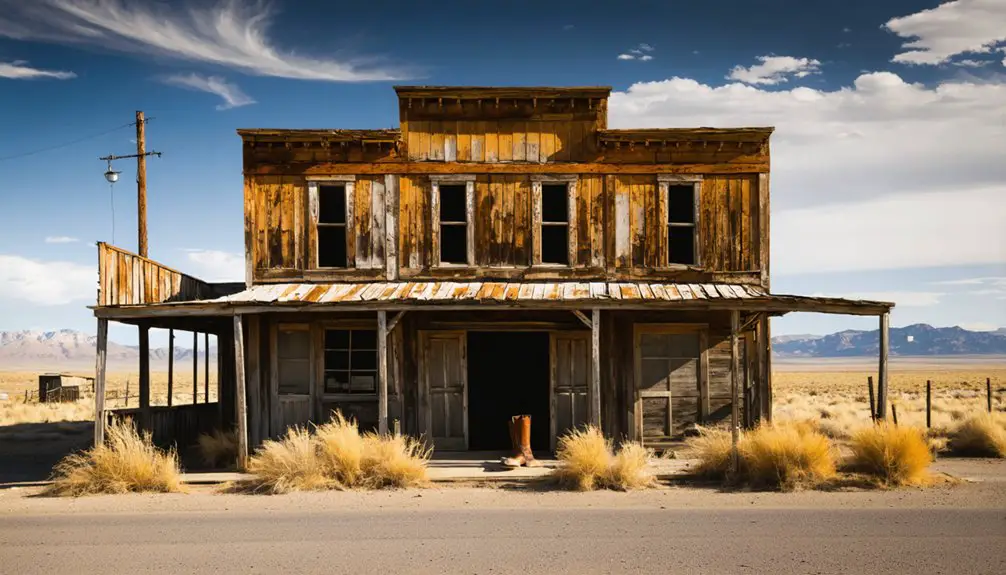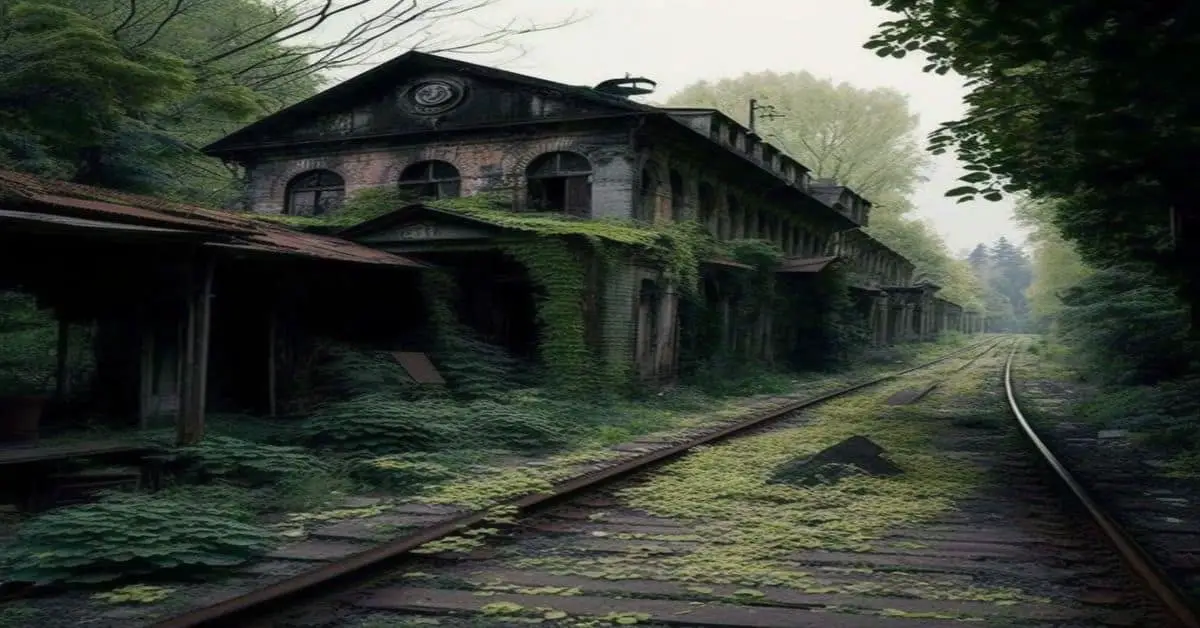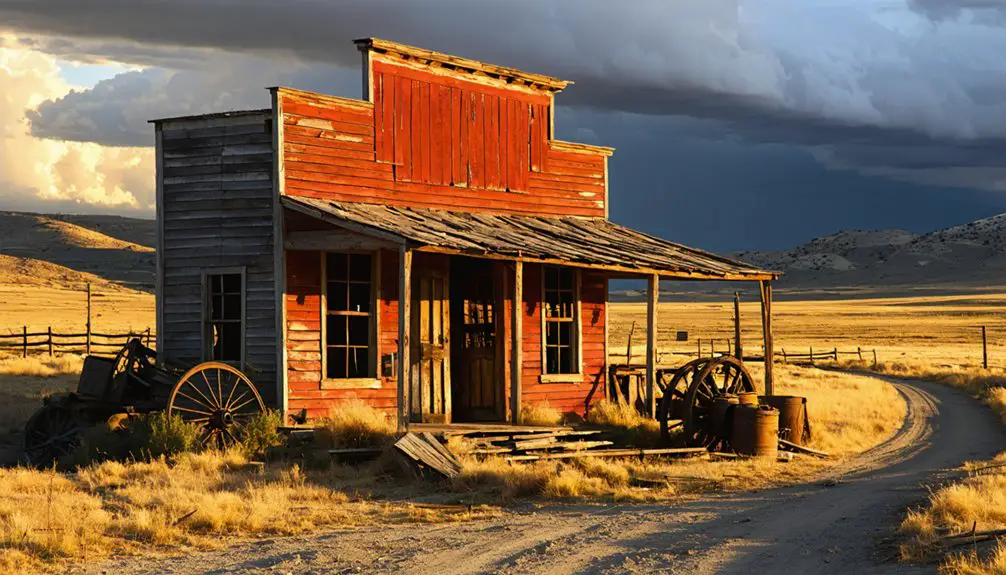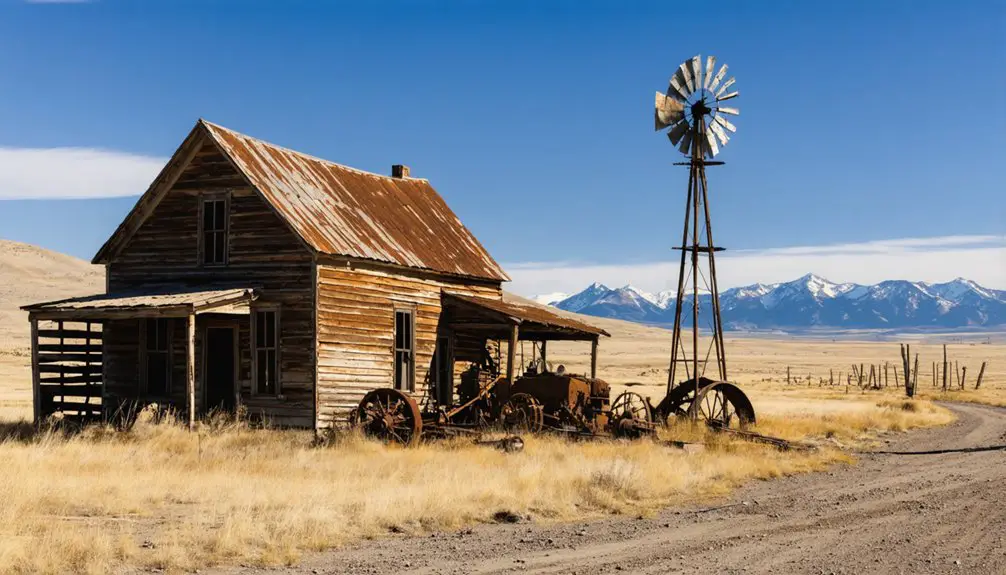You’ll find Wyoming’s ghost towns scattered across the state, each telling unique stories of mining booms and busts. South Pass City offers well-preserved gold rush buildings, while Jay Em showcases weathered ranching structures. Don’t miss Kirwin’s haunting mining ruins or Gebo’s coal mining remnants. Pack your 4×4, GPS, and sturdy boots for these remote adventures. These abandoned settlements hold countless secrets just waiting to be uncovered.
Key Takeaways
- South Pass City offers a well-preserved State Historic Site featuring over 250 original structures from Wyoming’s gold rush era.
- Jay Em showcases weathered buildings and ranching heritage, including the historic Farmers State Bank and Stone Company structures.
- Gebo’s remains include a cemetery and buildings from its coal mining heyday, when over 600 miners worked for Owl Creek Coal Company.
- Kirwin presents abandoned mining equipment, building foundations, and Amelia Earhart’s unfinished mountain retreat, accessible by four-wheel drive.
- Rudefeha, Dillon, and Rambler form a copper mining trio with preserved tramways, bunkhouses, and mining infrastructure from Wyoming’s copper era.
The Gold Rush Legacy of South Pass City
When a group of soldiers from Fort Bridger stumbled upon gold along Willow Creek in 1865, they set in motion one of Wyoming’s most significant gold rushes.
You can trace the fever that gripped the region back to 1867, when their initial claim sparked a rush that transformed this remote area into a bustling mining district. The Carissa Mine’s rich ore drew thousands of prospectors, and by 1869, you’d have found over 1,500 people seeking their fortune here. The town rapidly grew to include over 250 structures along its bustling main street.
But mining challenges quickly emerged. The Carissa’s ribbon-like vein formation made gold extraction tricky, and despite the discovery of roughly 1,500 lodes, most proved worthless. The town’s population plummeted as miners left for new finds in Bighorn.
Today, you’ll find South Pass City remarkably preserved as a State Historic Site, offering a genuine glimpse into Wyoming’s golden frontier days.
Life Among the Ruins at Jay Em
One Pony Express rider’s cattle brand would forever shape the destiny of Jay Em, Wyoming. James Moore’s “J Rolling M” ranch grew into the territory’s second-largest operation by 1869, leaving an indelible mark on the region’s ranching heritage.
You’ll find Jay Em’s story written in its weathered buildings, where Lake Harris established a crucial service hub between 1912 and 1915. The town’s no-frills layout speaks to the hardy spirit of Wyoming’s early settlers – no paved roads or fancy amenities, just the essentials needed to support local ranchers. The Farmers State Bank opened in 1920, marking a new era of growth for the town.
The town prospered as a regional commerce center when the Stone Company opened in 1935, producing high-quality building materials.
Despite its eventual decline in the late 1930s, Jay Em’s community resilience shines through its preserved structures.
Today, the Historic District stands as a reflection of the rugged independence that defined Wyoming’s rural service towns, where determined folks carved out a living from the untamed landscape.
Haunted Tales From Kirwin’s Mining Days
If you explore Kirwin today, you’ll hear chilling tales of the 1907 avalanche that killed several townspeople and drove the rest to flee, leaving their belongings behind.
During its heyday, Kirwin was a modern mining camp complete with a sawmill, power plant, and telephone lines that connected residents to the outside world.
Visitors often report hearing phantom sounds of mining equipment echoing through the abandoned valley, especially near the crumbling headquarters building where rusted machinery still stands.
You can even find the unfinished foundations of Amelia Earhart’s planned mountain retreat, which was abandoned after her disappearance and now adds another layer of mystery to this haunted ghost town.
The four-wheel drive requirement makes reaching this remote ghost town an adventure in itself, as visitors must navigate steep mountain roads and challenging creek crossings.
The Fatal 1907 Avalanche
After nine straight days of relentless snowfall, a massive avalanche descended from Brown Mountain on February 5, 1907, forever changing Kirwin’s fate.
You’ll find the avalanche aftermath was devastating – it swept C.L. Tewksbury’s store and home into the Wood River, claiming three lives: Mr. and Mrs. Charley Brunell and John Reynolds.
In Kirwin’s history, this catastrophe marked the beginning of the end. By spring, most residents had fled, leaving behind expensive machinery, modern appliances, and their dreams of striking it rich. The brutal winter conditions had made survival nearly impossible for the mining community.
They’d seen enough of the “white death” that lurked on the surrounding 12,000-foot peaks. The once-bustling mining town of 200 souls quickly deteriorated – roofs collapsed, windows shattered, and doors vanished, transforming this prosperous community into the haunting ghost town you can explore today. The town’s strict moral code meant there were no saloons or brothels to entertain the miners during their final days.
Phantom Mining Equipment Sounds
Deep in Kirwin’s abandoned mine shafts, you’ll hear something that’ll make your skin crawl – the ghostly echoes of mining equipment that hasn’t operated in over a century.
These phantom sounds have puzzled visitors and former miners alike, with reports of mysterious mining echoes drifting through the tunnels. The steam-driven pumps once used to remove water from the shafts are said to still create mysterious pumping sounds in the darkness. After the devastating avalanche of 1907, the mining town was largely abandoned, leaving behind these haunting remnants.
- Metallic clanking and rhythmic hammering from invisible sources
- Eerie machinery noises echoing through water-filled passages
- Whistling sounds created by wind rushing through fractured rock
- Underground streams amplifying ghostly mechanical echoes
- Unexplained drilling sounds reverberating from sealed tunnels
While scientists explain these phenomena through geology and natural causes, the haunting sounds add to Kirwin’s mystique.
The extensive network of tunnels, combined with temperature changes and settling rocks, creates an otherworldly symphony that’ll transport you back to the town’s mining heyday.
Earhart’s Unfinished Mountain Retreat
While Amelia Earhart’s legacy soars through aviation history, her ghostly presence lingers in the remote Wyoming wilderness at Kirwin.
You’ll find her unfinished cabin near Mount Sniffer, where only two walls stand as silent witnesses to her unfulfilled mountain dreams. In 1934, she and her husband George Palmer Putnam fell in love with this rugged terrain above 9,000 feet, filing a mining claim and commissioning local rancher Carl Dunrud to build their retreat.
Earhart’s ambitions for mountain solitude were cut short by her 1937 disappearance over the Pacific.
Today, you can visit this poignant site where the legendary aviator once hoped to escape from fame, surrounded by the towering peaks of the Absaroka Range that captured her adventurous spirit.
Hidden Springs and History at Eadsville
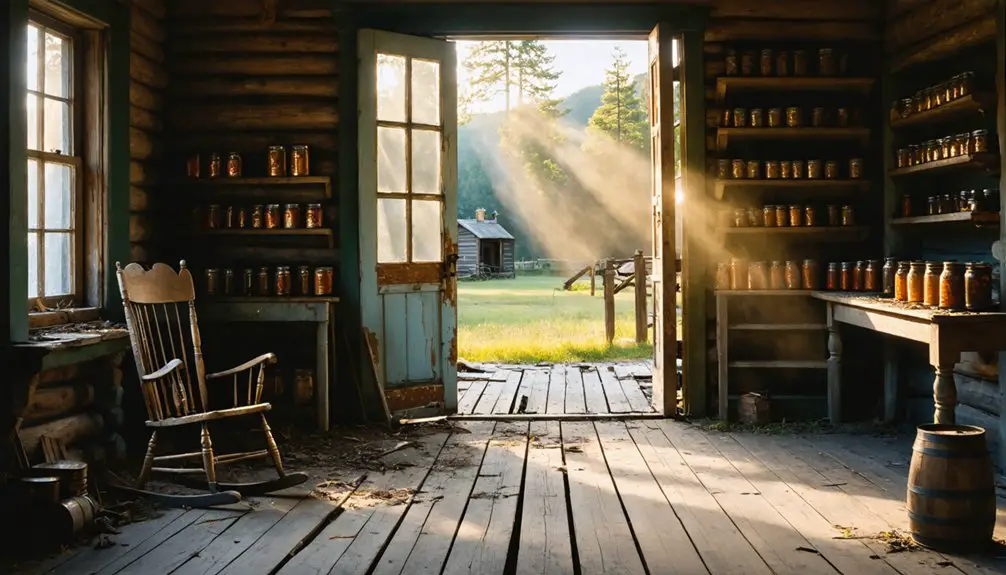
A hidden spring at 7,800 feet marks the spot where Charles W. Eads staked his mining claim in 1891, just 12 miles south of Casper.
You’ll find this ghost town perched atop Casper Mountain, where miners once sought their fortunes in precious metals but found steady work in asbestos and feldspar instead.
- Original town spanned 20 acres with dozen cabins housing 40-50 residents
- Mining techniques focused on extracting gold, silver, copper, and later spar
- Community life centered around supply stores serving local miners
- Spring remains as the heart of the former mining claim
- Only three cabin foundations and a small grave site remain visible today
Though largely abandoned by the early 1900s, you can still explore this slice of Wyoming’s mining heritage, now transformed into a recreational paradise for mountain biking enthusiasts.
Gebo: Wyoming’s Coal Mining Heritage
If you’re exploring Wyoming’s ghost towns, you’ll find that Gebo’s story captures the boom-and-bust cycle of coal mining, where over 600 miners and their families built lives around the profitable Owl Creek Coal Company until 1938.
Today, while most structures have vanished, you can still walk among the few remaining buildings and visit the cemetery that tells silent stories of the town’s vibrant past.
The town’s transformation from a bustling community of 2,000 residents to an abandoned site mirrors the broader decline of Wyoming’s early coal industry, though Gebo’s impact on federal mining regulations lives on.
Mining Life Until 1938
Since its founding in 1907, Gebo emerged as Hot Springs County’s powerhouse coal mining town, growing from Samuel Wilford Gebo’s vision into Wyoming’s largest coal operation of its time.
You’ll find the Gebo community faced tough mining challenges, working just 90 days a year at $3.50 per day.
Life in this bustling company town offered:
- A diverse population from 16 different nations working side by side
- Quality coal that burned hotter than competitors, attracting blacksmiths from miles away
- A vibrant social scene centered around the pool hall, school, and town band
- Seasonal work that forced families to get creative with side hustles like laundry and brewing
- Summer breaks when mines closed, letting workers escape the intense heat in nearby natural areas
Remains And Cemetery Today
Today’s visitors to Gebo find a stark contrast to the once-thriving mining town. After the 1971 bulldozing, you’ll discover only scattered foundations and a few weathered structures standing sentinel over Hot Springs County.
The heart of Gebo’s mining heritage lives on in its carefully maintained cemetery, where you’ll find touching reminders of frontier life’s harsh realities. Graves of miners, their families, and numerous children who succumbed to Spanish flu and diphtheria tell silent stories of early 20th-century hardships.
You can reach the Gebo cemetery by turning off US Highway 20 onto Sand Draw Road, though you’ll want to park and walk due to rough terrain. Watch for glass shards as you explore, and you’ll notice fresh flowers and coins left by descendants who still honor their ancestors.
The Lost Mining Trio: Rudefeha, Dillon, and Rambler
The fascinating Lost Mining Trio of Rudefeha, Dillon, and Rambler stands as a tribute to Wyoming’s copper mining legacy in southern Carbon County.
You’ll discover these ghost towns’ rich history dating back to the 1880s, when Rudefeha exploration began with Ed Haggarty’s copper discovery in 1897. Rambler history reveals it was founded earlier by George Doane, while Dillon was named after mining entrepreneur Malachi W. Dillon.
- Rudefeha Mine, named after investors Rumsey, Deal, Ferris, and Haggarty, led the trio’s copper production.
- Rambler developed as an alternative community when Rudefeha banned alcohol.
- Infrastructure included tramways, bunkhouses, and eating houses.
- Mines flourished until 1908 when copper prices dropped.
- By the 1930s, only scattered ruins and a few sheepherders remained.
Planning Your Wyoming Ghost Town Adventure
While historic mining towns like Rudefeha hold fascinating stories, visiting them requires careful planning and preparation.
You’ll want to time your ghost town adventures between late spring and early fall when accessibility is best, especially for high-elevation sites like Eadsville. Pack your high-clearance vehicle with essential gear: GPS, sturdy boots, layered clothing, and plenty of water.
Before heading out, research your destination’s historical preservation status and property boundaries to avoid trespassing. Many sites, like Kirwin and Gebo, are on public lands but require traversing rough forest roads.
Don’t forget to share your itinerary with someone back home – cell service is spotty, and emergency services are far away. Watch for hazards like unstable structures and unmarked mine shafts during your exploration.
Preserving Wyoming’s Abandoned Past
Preserving Wyoming’s historic ghost towns requires a delicate balance of state intervention and community support to keep these cultural treasures intact.
You’ll find dedicated teams working tirelessly against harsh weather and limited funding to protect these remnants of the Old West. Restoration challenges include stabilizing original structures and protecting thousands of artifacts while managing visitor impact.
- State agencies maintain authentic buildings using period-accurate materials
- Archaeological research helps recover and preserve mining equipment
- Local museums curate artifacts and host educational exhibits
- Annual heritage festivals generate preservation funding
- Careful documentation guides ongoing conservation efforts
You can experience this preservation firsthand through interactive experiences like gold panning demonstrations and educational programs.
These efforts guarantee that Wyoming’s mining heritage remains accessible while protecting it for future generations to explore.
Best Times to Visit Wyoming’s Ghost Towns
Planning your visit to Wyoming’s ghost towns requires careful consideration of seasonal conditions that can make or break your experience.
You’ll find the sweet spot between late spring and early fall when roads are most accessible and weather’s at its best.
Summer brings organized events like Gold Rush Days in South Pass City, though you’ll share the experience with more visitors.
For a quieter adventure, try fall – you’ll get stunning foliage and fewer crowds. Just pack layers since temperatures can drop quickly at higher elevations.
Keep these seasonal tips in mind: check road conditions before heading out, visit early morning to beat crowds, and be prepared for wildlife encounters.
Spring’s beautiful but watch for muddy roads, while winter’s harsh conditions make many ghost towns practically unreachable.
Frequently Asked Questions
Are There Guided Tours Available at These Ghost Towns?
You’ll find guided tours highlighting historical significance at South Pass City and Kirwin Ghost Town, while local experts lead you through other Wyoming locations, sharing stories during seasonal adventures.
What Wildlife Encounters Should Visitors Be Prepared For?
Like Goldilocks in bear country, you’ll need to stay alert! From grizzlies and black bears to mountain lions, moose, and rattlesnakes, wildlife safety’s essential when exploring. Animal sightings are common at dawn and dusk.
Can Metal Detectors Be Used at Wyoming Ghost Town Sites?
You can’t use metal detectors at Wyoming ghost town sites due to strict metal detecting regulations protecting historical artifacts. You’ll need special permits for public lands and written permission for private property.
Are Overnight Camping or Paranormal Investigations Permitted in These Locations?
You’ll need permits for camping and must follow strict regulations. For paranormal activities, you’ve got to get permission from landowners or agencies that manage the sites. Don’t risk unauthorized investigations.
Which Ghost Towns Are Accessible During Winter Months by Vehicle?
Like a winter explorer charting new territory, you’ll find Fort Fred Steele’s your best bet for vehicle access, while Kirwin and Eadsville offer limited winter routes if you’ve got 4-wheel drive.
References
- https://www.onlyinyourstate.com/experiences/wyoming/creepy-ghost-towns-in-wy
- https://travelwyoming.com/blog/stories/post/5-wyoming-ghost-towns-you-need-to-explore/
- https://sites.rootsweb.com/~wytttp/ghosttowns.htm
- https://www.wyomingcarboncounty.com/things-to-do/?id=123:5-ghost-towns-to-explore
- https://www.youtube.com/watch?v=GEoxbcwf8Ks
- https://shirleendavies.com/a-frontier-gold-rush-town-south-pass-city-wyoming/
- https://www.susantregoning.com/blog/south-pass-city
- https://www.wyohistory.org/encyclopedia/south-pass-gold-rush
- https://www.youtube.com/watch?v=UL-0irwrmhA
- https://centerofthewest.org/2018/07/13/gold-miners-of-south-pass/
